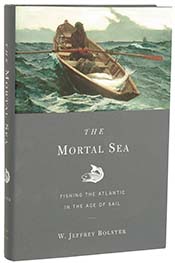 |
 |
| current issue |  |
past issues |  |
send a letter/news |  |
address update |  |
advertise |  |
about us |  |
alumni home |
Previews
|
|
|
Dating back four centuries, overfishing is still with us today. The Mortal Sea: Fishing the Atlantic in the Age of Sail by Janice Harayda '70 Fishermen love to talk about "the one that got away." But something much larger has gotten away from us, W. Jeffrey Bolster shows in his powerful new book, The Mortal Sea: Fishing the Atlantic in the Age of Sail (Belknap/Harvard, 2012). For more than four centuries, writes the associate professor of history, people have squandered chances to rein in the overfishing that has put the North Atlantic in ecological peril.
Early visitors to New England marveled at the richness of life in its waters. "The abundance of sea fish are almost beyond believing," an English clergyman in Massachusetts wrote in 1629. Settlers named tributaries of the Piscataqua River, including the Oyster River, for their natural bounty. But the depletion began quickly. By the 1700s, each generation saw fewer whales, bass, sturgeon and shellfish. Instead of treating the declines as a portent, observers viewed them as the new norm, an example of what ecologists call the "shifting baseline syndrome." Often the losses defied belief. When halibut disappeared from Georges Bank in the mid-19th century, one sea captain theorized that the fish had "shifted off" into deeper water. He couldn't grasp, Bolster writes, that they had been largely eradicated. It had taken only 15 years for a small fleet of schooners "nearly to wipe out most of the halibut stock on a bank approximately equal in area to the combined size of Massachusetts, Rhode Island, and Connecticut."
Advances in technology hastened the losses, perhaps none more so than the 20th-century trawler—its net sweeping along the bottom, taking everything in its path—that could harvest in an hour what a 17th-century vessel could catch in a season. At every step, Bolster argues, precautions and a more imaginative vision of the future could have made a difference. Even in the modern age of keen environmental awareness, the crisis continues to affect not just our food supply and the enjoyment of weekend fly-casters but the resilience of one of the world's largest ecosystems. A lifelong seafarer, Bolster writes from a deep love of the ocean that dates back to his first boat, an 8-foot dingy bought with money from his paper route. (Sailing continues to be a passion: While others headed for ski slopes, he recently sailed to the Virgin Islands during a winter vacation.) A solution to overfishing, he says, will require "a fundamental reorientation" in thinking about marine life. And because some changes will need to come from regulators, he says he hopes the book "is read by policy makers." ~ |
Overviews: The Iciest, Diciest, Scariest Sled Ride Ever!
The Iciest, Diciest, Scariest Sled Ride Ever!Rebecca Rule '76, '79G, illustrated by Jennifer Thermes Seven children pile onto a runner sled for the ride of a lifetime in a lively new picture book by an acclaimed storyteller. The fun comes from more than the high action: The illustrations brim with picturesque details—a red barn, a covered bridge, "white, bright mountains."
 Quarantine
Quarantineby John Smolens '82G One of America's most entertaining historical novelists brings to life a part of New England history in this story of a 1796 yellow fever outbreak in Newburyport, Mass. The fast-paced plot involves a quarantined ship, an infected crew, and a secret romance kept "quarantined" by two lovers.
 The Armageddon Letters: Kennedy/Khruschev/Castro in the Cuban Missile Crisis
The Armageddon Letters: Kennedy/Khruschev/Castro in the Cuban Missile Crisis by James G. Blight '73G, '74G and Janet M. Lang '74, '77G and others The authors take a pioneering approach in this transmedia project that shows how close we were to nuclear war during the Cuban Missile Crisis. |
  
Web Extras Additional books by UNH alumni and faculty and staff members: Bob Begiebing '77G Ginny Lowe Connors '73 B.W. DeCaro '95 Daniel Ford '54 Lania Knight '91 Ralph LaRossa '75G Emily Neuburger '99 Don Silva '57, '65G John Smolens '82G Nathaniel Tilton '94 | |
|
Bob Begiebing '77G The Strange Death of Mistress Coffin Based on Exeter's first murder case (and New Hampshire's first case to be widely noted throughout the New England colonies), The Strange Death of Mistress Coffin explores the prejudices and passions of people struggling to establish communities in seventeenth-century New Hampshire. The crime remained unsolved but with court records and a descriptive entry about the crime in Governor John Winthrop's Journal, so the colonial records of this unsolved case made a perfect foundation for a book of fiction. Mistress Coffin is a tale of men and women in their ageless struggles against nature, one another, and their inner selves. The colonial sources revealed not only an ancient mystery, but a record of human beings not so very different from ourselves today, even though the historical figures had to live in a social, political, and religious setting largely unrecognizable to contemporary men and women. See at amazon.com |
 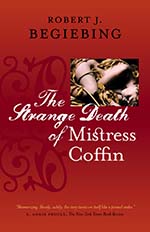 |
|
Ginny Lowe Connors '73 The Unparalleled Beauty of a Crooked Line In this collection, joy and regret cohabit the poems like the dragonflies the poet sees joined together brilliantly in their courtship over the simmer of evening water. The poet Natasha Saje writes about Connors' latest poetry collection: "'The poet doesn't invent. She listens,' said Jean Cocteau. Ginny Connors' new book, The Unparalleled Beauty of a Crooked Line, is full of empathetic listening. Connors' ear is pitch-perfect, and her poems make the reader grateful for a soul like hers, someone who names her two hands 'Tenderness' and 'Slaughter,' someone who knows unparalleled difficulty alongside unparalleled beauty." The poet and naturalist David K. Leff says of Connors' poems that she finds the language to translate "simple things like a handful of berries, a chunk of frozen brick, the scent of sage, a toad, or a dollop of fudge into talismans that make a delightfully magical sacrament from thee most ordinary experience." To read a few selections from this book, visit antrimhousebooks.com/connors2.html#poems. Ginny Lowe Connors is the author of Barbarians in the Kitchen (Antrim House Books, 2005) as well as a chapbook, Under the Porch (Hill-Stead Museum, 2010). She runs a small poetry press, Grayson Books, and is the editor of four poetry collections: Essential Love, To Love One Another, Proposing on the Brooklyn Bridge, and Where Flowers Bloom. She has won numerous awards for her poetry, including Atlanta Review's International Poetry Competition Prize and the 3020 Sunken Garden Poetry Prize. An English teacher in West Hartford, Connecticut, in 2003 she was named Poet of the Year by the New England Association of Teachers of English. See at amazon.com |
 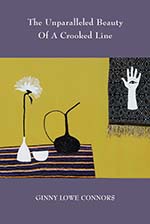 |
B.W. DeCaro '95 Grown Men Don't Cry As the popular jocks in the one-stoplight town of Bristol, New Hampshire, Ben Chase and Jimmy Keller are best friends whose unique creativity and bold personalities make for some hilarious--and heart-wrenching--stories. Laughter doesn't make up for pain inflicted by their dysfunctional families, but it certainly creates some unforgettable memories. Growing up, Ben has viewed his Obsessive Compulsive Disorder (OCD) as nothing more than a nuisance. Then all hell breaks loose the day that he becomes a father and realizes there is a lot in the world that he can't control. Meanwhile, Jimmy is battling his own demons. Since his return from his third tour of duty in Iraq, he has suffered from a severe case of Post Traumatic Stress Disorder (PTSD). Declaring he's had enough, Jimmy makes the conscious choice to end his life. While out enjoying what is supposed to be his last meal, Jimmy overhears a conversation about a former baseball standout that has just months to live, and discovers it's his old friend. Jimmy puts his suicide mission on hold to reconnect with Ben. In their weakest moments, it's now shared pain which helps rekindle their unbreakable bond. Grown Men Don't Cry is the story of sacrifice, friendship, mortality and the will to persevere. B.W. DeCaro grew up in New England, spending his teenage years in Bristol, New Hampshire. He attended the University of New Hampshire ('95), and soon after moved to Northern Virginia, where he now lives with his wife and two children. Grown Men Don't Cry is his first novel. A portion of all book proceeds will be donated to causes supporting people who suffer from depression and other anxiety disorders, such as OCD and PTSD. In addition, B.W. DeCaro plans to use this platform to help educate the general public by striving to eliminate the negative stigma associated with mental illness. Website Twitter: Twitter Amazon Paperback/Reviews Amazon Kindle |
 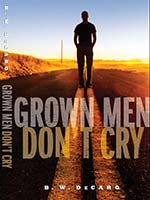 |
Daniel Ford '54 A Death in the Forest: A Polish Family Caught Between Germany and Russia, 1939-1940 When he graduated from UNH, Dan Ford became a Fulbright Scholar at the University of Manchester city in England's gritty northwest. There he met Basia Deszberg—born in Poland, exiled to Kazakhstan, escaped to Persia, and finally emigrated to England as a "displaced person" in 1948. Many years later, they met again, and he set out to write their joint history as children in the Second World War and students afterward. It's still a work in progress, but Dan has published three early chapters as an e-book. They cover the events of 1939 ("War Comes to Potocki Street"), the murder of Basia's father and 21,000 other Polish officers and civilian leaders ("A Death in the Forest"), and the dispatch of hundreds of thousands of Polish civilians to the Gulag ("The Sky Was Green"). "What struck me about Basia's childhood," Dan says today, "is how radically it differed from mine. She was the daughter of a well-off family that lost almost everything—including her homeland, which was incorporated into the Soviet Union. Meanwhile I was running barefoot on a dirt road in East Alton, growing up in a poverty almost unimaginable today. But while Poland spiraled downward, America became in a very few years the richest country in the world, so that I found myself privileged to spend four years in Europe as a student, vagabond, soldier, and journalist. It's almost as though her affluence was transferred to me, and Poland's to the United States. When the book is finished, I hope this will all make some kind of sense to me. In the meantime, I welcome comments." See at amazon.com (Kindle edition. Also available for the B&N Nook, Kobo reader, and Apple iPad) DanFordBooks.com |
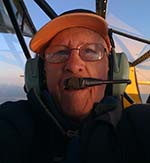 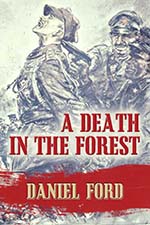 |
Lania Knight '91 Three Cubic Feet Three Cubic Feet is a story about the body—how it can be broken, how it can be violated and sometimes used to violate others. And yet, we go on. We heal, and life continues. Eric Goodman, author of Child of My Right Hand and Twelfth and Race, says of the book, "Lania Knight renders a touching and violent coming of age. Gay and straight, her characters leap off the page and grab our hearts." The book is set in the Ozark Mountains of Missouri. The author studied Plant Science and Environmental Conservation at UNH, and she brings her love of place and plant life to her writing. Her main character, a teenager named Theo, is still haunted by the echoes of his dead mother, a botanical illustrator who left plant taxonomies and stacks of drawings to her son when she died. When Theo experiences the natural world, he sees its beauty through his mother's eyes. In Three Cubic Feet, we follow the story of Theo Williamson as he comes to terms with the memories of his mother, and the conflicting demands from his family and friends amidst the backdrop of Springfield, Missouri, an oppressive town hostile to change and intolerant of gays. Theo's family knows he's gay, and they have good intentions, but his father is recovering from a car accident, and Theo's stepmother won't give him a moment to himself. Taking its title from a song by Loudon Wainwright III, "One Man Guy," the book focuses on Theo's guy problems—the closeted older man he has seduced while on vacation who now wants nothing to do with Theo, and Theo's best friend Jonathan who isn't interested in anything more than friendship. Theo struggles with his connections to his family, with the changing dynamics of all his relationships with men, including the growing anger and resentment he feels toward best friend's volatile, controlling father. By the end of the book, Theo's best friend's father turns violent, and Theo must decide just how far he is willing to go for love. See at amazon.com |
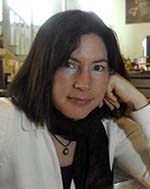 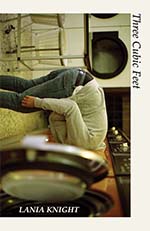 |
Ralph LaRossa '75G Of War and Men: World War II in the Lives of Fathers and Their Families Fathers in the fifties tend to be portrayed as wise and genial pipe-smokers or distant, emotionless patriarchs. This common but limited stereotype obscures the remarkable diversity of their experiences and those of their children. To uncover the real story of fatherhood during this transformation, Ralph LaRossa takes the long view—from the attack on Pearl Harbor up to the election of John F. Kennedy—revealing the myriad ways that World War II and its aftermath shaped men. Offering compelling accounts of people both ordinary and extraordinary, Of War and Men digs deep into the terrain of fatherhood. LaRossa explores the nature and aftereffects of combat, the culture of fear during the Cold War, the ways that fear altered the lives of racial and sexual minorities, and how the civil rights movement affected families both black and white. Overturning some calcified myths, LaRossa also analyzes the impact of suburbanization on fathers and their kids, discovering that living in the suburbs often strengthened their bond. And finally, looking beyond the idealized dad enshrined in TV sitcoms, Of War and Men explores the brutal side of family life in the postwar years. LaRossa's richly researched book dismantles stereotypes while offering up a fascinating and incisive chronicle of fatherhood in all its complexity. University of Chicago Press History of Fatherhood Project See at amazon.com |
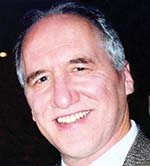 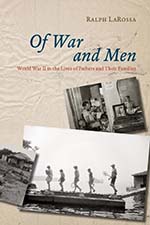 |
Emily Neuburger '99 Show Me a Story: 40 Craft Projects and Activities to Spark Children's Storytelling Show Me a Story: 40 Craft Projects and Activities to Spark Children's Storytelling (Storey Publishing) is a curriculum rich book with projects and activities that nurture children's natural inclination to tell their own imaginative stories. Children love to make up stories, and these 40 creative projects and activities encourage them to free their storytelling instincts. Younger children will love making story stones and a storytelling jar and then using them to create stories of their own, while older kids will enjoy word grab bags, story walks, and journaling exercises. For everyone ages 5 to 12, whatever their reading level, this book has everything needed to spark an infinite number of child-created stories. It is a truly inspiring companion for anyone who does creative work with children. Emily Neuburger is an artist, teacher, and children's craft designer behind the blog, Red Bird Crafts. She is a contributor to Family Fun Magazine and authors their Everyday Fun blog on Parents.com. She has been teaching language and expressive arts to children and teens for over a decade. After receiving her B.A. in Psychology at UNH and her Masters of Arts in Teaching (M.A.T) from Smith College, she happily taught English and writing at two Massachusetts high schools before becoming a local creative arts and writing educator. Throughout her teaching career, she's been especially interested in how art informs writing and vice versa, and how both nurture people's capacity to imagine. She teaches classes to both children and adults in her home classroom as well as in libraries and schools. Her curriculum is a balanced blend of skill-based learning, encouragement, and lessons in self-discovery and artistic experimentation. She writes regularly about creative living and unexpected treasures. Many of her projects for children have been published across the web on popular sites such as Poppytalk, Apartment Therapy, Crafty Crow, Craftzine, and in both Family Fun and Parenting print magazines. See at amazon.com |
 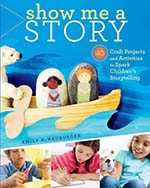 |
Don Silva '57, '65G A Trail of Dreams: Thoreau in Love Here's Henry Thoreau—youthful, right out of college, questioning society, rejecting a profession, looking for companionship, home from Harvard. Will he regain his youth? Can he find a job or must he work at home? A farming town, Concord's changed - more taverns, political parties, anti-slavery and temperance—America's in an economic crisis. Teamsters drink on the porch of the Middlesex Hotel. Emerson's first book attracts attention—to live life, turn to nature. Lucy Brown, mother of two grown children, abandoned, sister of Lidian Emerson, lonely and seeking intellectual conversation, lives with the Thoreaus. Cynthia Thoreau, shrewd, and determined, runs her boarding house and family with a steady hand and wants Henry,not a ne'er-do-well, but in a profession. A Trail of Dreams Henry Thoreau returns from college seeking the town he loved as a boy. He finds change and difficulty. His mother opens a boarding house and his father manufactures pencils. He doesn't like business. He wants to walk in the woods and find himself. Lucy Brown with two grown children and abandoned by her husband stays with Mrs. Thoreau and visits her sister Lidian Emerson. She wants Henry to follow his dreams and antagonizes Mrs. Thoreau, taking walks with Henry, introducing him to Ralph Waldo Emerson. She talks about religion, art, and literature. Mrs. Thoreau insists he work around the boarding house and assist his father making pencils. She sees the benefit in knowing the Emersons. She believes that friendship takes precedence over love. Ellen Sewall, 17 years old, arrives from Scituate to visit her aunt and grandmother living in the boarding house. Henry and his brother John escort her on walks and to house parties and fall in love. Henry dreams of getting away. He builds a boat and he and his brother sail by river to New Hampshire and take a stagecoach north and climb the highest mountain. His brother in love with Ellen and planning to propose marriage. Mr. Emerson's impressed and offers work for room and board. They take walks and discuss poetry and nature. Mrs. Thoreau blames Lucy for the job offer and resists Henry's leaving home. The boarding house distracts Henry from writing and keep him from daily walks. Lucy urges him to accept Mr. Emerson's proposal. Will he leave home and pursue his dream or will he settle down at home? Will Lucy be his friend or lover? See at amazon.com |
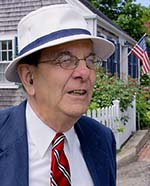 Jim Cerny  |
John Smolens '82G Quarantine In 1796, a trading ship arrives in Newburyport, Massachusetts, its crew decimated by a virulent fever which causes residents of the harbor town to fall ill and die with alarming haste. When physician Giles Wiggins places the port under quarantine, he earns the ire of his shipbuilder half-brother, Enoch Sumner, and their eccentric mother, Miranda. Defiantly, Giles sets up a pest-house, where the afflicted might be cared for and separated from the rest of the populace. As the seaport descends into panic, religious fervor, and mob rule, bizarre occurrences ensue: the harbormaster's family falls victim to the fever, except for his son, Leander Hatch, who is taken in at the Sumner mansion, where he challenges order and tradition; a young woman, Marie Montpelier, is fished out of the Merrimack River, causing Giles and Enoch—who is convinced she's the expatriate daughter of the French king—to vie for her attentions; and medical supplies are pillaged by a black marketer from Boston. As the epidemic grows, fear, greed, and unhinged obsession threaten the Sumner family—and the future of Newburyport itself. Quarantine is John Smolens' eloquent, darkly ironic portrait of an early American city under duress caused by a mysterious pestilence, and of a prominent family which succumbs to its own corrupt influence and desires. "Smolens delivers an intriguing story of late 18th-century sea-faring suffering...Smolens's research puts the reader right in the moment, and his keen understanding of human nature during turmoil makes for a fascinating read." —Publishers Weekly (9/17/12) "John Smolens is that rare and gifted writer who can capture both our exterior and interior worlds with equal dexterity, grace and power. His characters will stay with you long after turning the last page." —Andre Dubus III (Townies) "A fine writer with a profound knowledge of human behavior gone awry." —Jim Harrison (Legends of the Fall) See at amazon.com |
 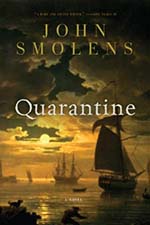 |
|
Nathaniel Tilton '94 The Blackjack Life Author Nathaniel Tilton was leading a normal life in Boston as a financial advisor. Inspired by the books Bringing Down the House and Busting Vegas, which were true stories about the famous MIT blackjack teams of the 1990s, Tilton began to explore the game of advantage blackjack. The Blackjack Life takes the reader on his personal journey through the inner world of card counting, the lessons of teamwork, and the clandestine pursuit to beat the odds. Tilton recounts the story of his playing career, from the smoke-filled casinos in which he and his playing partner gambled, to the seedy backrooms that he hoped he would never see. Over several years, Tilton developed into a world-class player, respected by his card counting brethren, and feared by the casinos in which he played. But more than just wins and losses, The Blackjack Life is about the growth of a man who discovered himself through the unlikeliest of places—the world of professional blackjack—and who now shares his informed view of the opportunities that still exist for skilled players and what it's really like to travel that road today. See at amazon.com |
 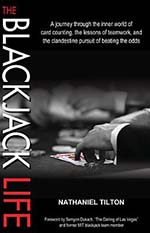 |
blog comments powered by Disqus


